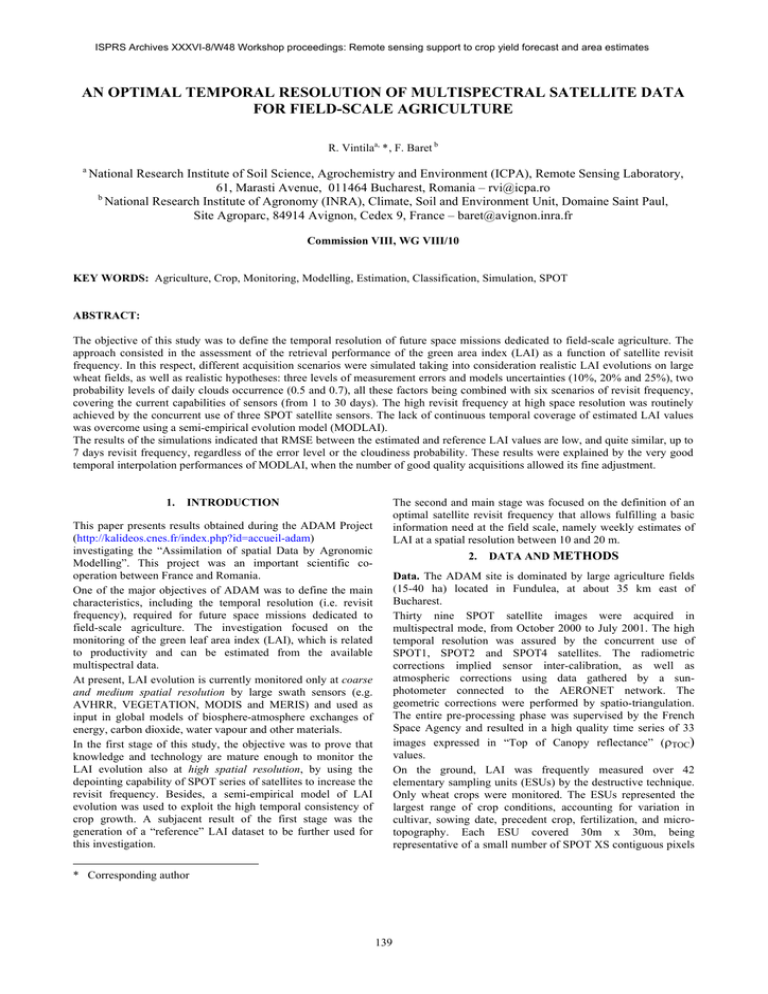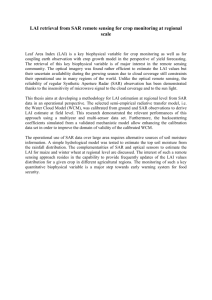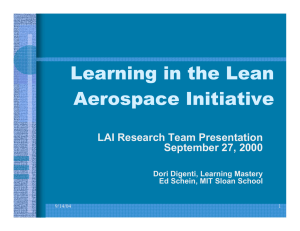Document 11869405
advertisement

ISPRS Archives XXXVI-8/W48 Workshop proceedings: Remote sensing support to crop yield forecast and area estimates AN OPTIMAL TEMPORAL RESOLUTION OF MULTISPECTRAL SATELLITE DATA FOR FIELD-SCALE AGRICULTURE R. Vintilaa, *, F. Baret b a National Research Institute of Soil Science, Agrochemistry and Environment (ICPA), Remote Sensing Laboratory, 61, Marasti Avenue, 011464 Bucharest, Romania – rvi@icpa.ro b National Research Institute of Agronomy (INRA), Climate, Soil and Environment Unit, Domaine Saint Paul, Site Agroparc, 84914 Avignon, Cedex 9, France – baret@avignon.inra.fr Commission VIII, WG VIII/10 KEY WORDS: Agriculture, Crop, Monitoring, Modelling, Estimation, Classification, Simulation, SPOT ABSTRACT: The objective of this study was to define the temporal resolution of future space missions dedicated to field-scale agriculture. The approach consisted in the assessment of the retrieval performance of the green area index (LAI) as a function of satellite revisit frequency. In this respect, different acquisition scenarios were simulated taking into consideration realistic LAI evolutions on large wheat fields, as well as realistic hypotheses: three levels of measurement errors and models uncertainties (10%, 20% and 25%), two probability levels of daily clouds occurrence (0.5 and 0.7), all these factors being combined with six scenarios of revisit frequency, covering the current capabilities of sensors (from 1 to 30 days). The high revisit frequency at high space resolution was routinely achieved by the concurrent use of three SPOT satellite sensors. The lack of continuous temporal coverage of estimated LAI values was overcome using a semi-empirical evolution model (MODLAI). The results of the simulations indicated that RMSE between the estimated and reference LAI values are low, and quite similar, up to 7 days revisit frequency, regardless of the error level or the cloudiness probability. These results were explained by the very good temporal interpolation performances of MODLAI, when the number of good quality acquisitions allowed its fine adjustment. 1. The second and main stage was focused on the definition of an optimal satellite revisit frequency that allows fulfilling a basic information need at the field scale, namely weekly estimates of LAI at a spatial resolution between 10 and 20 m. INTRODUCTION This paper presents results obtained during the ADAM Project (http://kalideos.cnes.fr/index.php?id=accueil-adam) investigating the “Assimilation of spatial Data by Agronomic Modelling”. This project was an important scientific cooperation between France and Romania. One of the major objectives of ADAM was to define the main characteristics, including the temporal resolution (i.e. revisit frequency), required for future space missions dedicated to field-scale agriculture. The investigation focused on the monitoring of the green leaf area index (LAI), which is related to productivity and can be estimated from the available multispectral data. At present, LAI evolution is currently monitored only at coarse and medium spatial resolution by large swath sensors (e.g. AVHRR, VEGETATION, MODIS and MERIS) and used as input in global models of biosphere-atmosphere exchanges of energy, carbon dioxide, water vapour and other materials. In the first stage of this study, the objective was to prove that knowledge and technology are mature enough to monitor the LAI evolution also at high spatial resolution, by using the depointing capability of SPOT series of satellites to increase the revisit frequency. Besides, a semi-empirical model of LAI evolution was used to exploit the high temporal consistency of crop growth. A subjacent result of the first stage was the generation of a “reference” LAI dataset to be further used for this investigation. 2. DATA AND METHODS Data. The ADAM site is dominated by large agriculture fields (15-40 ha) located in Fundulea, at about 35 km east of Bucharest. Thirty nine SPOT satellite images were acquired in multispectral mode, from October 2000 to July 2001. The high temporal resolution was assured by the concurrent use of SPOT1, SPOT2 and SPOT4 satellites. The radiometric corrections implied sensor inter-calibration, as well as atmospheric corrections using data gathered by a sunphotometer connected to the AERONET network. The geometric corrections were performed by spatio-triangulation. The entire pre-processing phase was supervised by the French Space Agency and resulted in a high quality time series of 33 images expressed in “Top of Canopy reflectance” (ρTOC) values. On the ground, LAI was frequently measured over 42 elementary sampling units (ESUs) by the destructive technique. Only wheat crops were monitored. The ESUs represented the largest range of crop conditions, accounting for variation in cultivar, sowing date, precedent crop, fertilization, and microtopography. Each ESU covered 30m x 30m, being representative of a small number of SPOT XS contiguous pixels * Corresponding author 139 ISPRS Archives XXXVI-8/W48 Workshop proceedings: Remote sensing support to crop yield forecast and area estimates (about 1 ha total area). Ten more frequently sampled ESUs were intended for the method calibration, and the remaining 32 for its validation. The meteorological data were continuously gathered by an automatic station installed in the ADAM site centre. Methods. Figure 1 illustrates the flow of procedures carried out throughout this study. For the clarity of explanations, the MODLAI model appearing several times in Figure 1 will be described at this point. MODLAI was inspired by an evolution model first defined by Baret and Guyot (1986). In the present study, MODLAI describes the LAI evolution as a function of the “accumulated daily mean air temperature” (above 0°C for wheat) starting from sowing, variable named T in Equation (1): ⎡ ⎤ 1 − ea (T − Ts ) ⎥ LAI = K ⎢ − b (T − Ti ) ⎣1 + e ⎦ dates of ground sampling on the 32 validation units (VUs). The performance was again very good ( “Results” section, Figure 3). Thus, it was demonstrated that knowledge and technology are sufficient mature to monitor LAI at high spatial resolution. In particular, it was possible to regard the daily LAI estimates over the 42 ESUs as daily “true” values. Nevertheless, considering the actual updating need, which is once a week, the daily “true” LAI was sampled to generate a weekly data set to serve as “reference” LAI for the next stage of the project. Figure 1 Methods diagram (1) The main advantages of MODLAI are the availability of T in practice and the reduced number of parameters, all the more so they have biological meanings: K = amplitude of the maximal leaf area Ti = accumulated temperature at the first inflexion point b = relative growth rate at Ti temperature a = relative senescence rate, and Ts = accumulated temperature at the time of green leaves disappearance Back to Figure 1, the top section (coded “I”) shows the steps accomplished during the first stage of this study: - The MODLAI parameters were estimated for each calibration unit (CU) by model inversion, using the look-up table (LUT) method for global optimization (Knyazikhin et al., 1998). - After adjustment, MODLAI was run in the forward direction to estimate LAI over the CUs at the satellite acquisition dates. - Next, for each acquisition date, a transfer function was determined by multiple linear regression: 3 LAI( t ) = α 0 + ∑ α bρTOC, b ( t ) + ε (2) b =1 where b = SPOT band number (G = 1, R = 2, and NIR = 3) αi (i = 0..3) = regression coefficients, and ε = residual - MODLAI was adjusted again by the same LUT method, this time using the LAI values retrieved thanks to the transfer functions and the corresponding satellite data. This enabled the daily estimation of LAI on CUs. - The performance of the LAI retrieval was evaluated by calculating the coefficient of determination (R²) and the root mean square error (RMSE) between measured and estimated LAI at the dates of ground sampling on CUs. The very good performance, shown in the “Results” section (Figure 2), accounted for the next steps. - The validation of the retrieval method started with a multitemporal classification applied over the wheat fields using the time series of SPOT images. In this respect, the ISODATA algorithm was used under the assumption that thirty TOC reflectance classes can adequately describe the spatial and temporal variability of the wheat fields. - The estimation of the LAI values for each ISODATA class was achieved using the previous transfer functions. - MODLAI was again readjusted based on the last LAI estimates and the corresponding satellite data; it was then run to estimate the daily LAI values over all wheat fields. - The overall retrieval performance was evaluated calculating R2 and RMSE between measured and estimated LAI at the The objective of the second stage was to define an optimal temporal resolution of satellite data to fulfil the basic need at the field scale to dispose of weekly estimates of LAI at a spatial resolution between 10 and 20 m. The approach was based on the simulation of tens of thousands of acquisition scenarios over the 42 ESUs. The scenarios were defined under the following hypotheses: (i) 3 levels of LAI retrieval errors (modelled as additive white Gaussian noise): 10%, 20%, and 25%; (ii) 6 satellite revisit frequencies: 1, 2, 3, 7, 15, and 30 days; (iii) 2 probability levels of daily clouds occurrence: 0.5 and 0.7. The steps performed during this stage are shown in the bottom section of Figure 1 (coded “II”): 140 ISPRS Archives XXXVI-8/W48 Workshop proceedings: Remote sensing support to crop yield forecast and area estimates - According to the first hypothesis, several daily “noisy” LAI data sets were generated from the daily “true” LAI. Further, the hypothesis on the revisit frequencies, with the start day of the orbital cycle randomly selected, transformed the daily “noisy” LAI data sets into ad-hoc called “observable” LAI data sets. - The third hypothesis on cloudiness further selected the ad hoc called “observed” LAI data sets. - The continuous temporal coverage of LAI estimates was generated using again MODLAI. - An optimal temporal resolution of satellite data was defined by evaluating the retrieval performance for all scenarios (Figure 4 below). RMSE was calculated between the estimated and reference LAI, for each fixed weekly date of the growth cycle. 3. 4. CONCLUSION AND PERSPECTIVES The main conclusion of this study is that combining reasonably high temporal and spatial resolution satellite images - weekly RESULTS AND DISCUSSION The good performance of LAI retrieval during the first stage of the study is illustrated below. Thus, it can be seen in Figure 2 that RMSE ≈ 0.28 between measured and estimated LAI on the calibration units, while R2 ≈ 0.96, and in Figure 3 that MODLAI has a good capacity to describe the LAI evolution on the validation units (performance shown for VU26). The results of the second stage were obtained by repeating (3x6x2x42) scenarios 35 times, to get values statistically meaningful while accounting for the random character of clouds occurrence and individual LAI retrieval uncertainties. Figure 4 shows the overall retrieval performance as a function of satellite revisit frequency. Results indicate that the errors of the weekly LAI estimates as compared to the reference LAI are low and quite similar up to 7 days revisit frequency. MODLAI was always well adjusted to the dataset of individual observations, when their number was large enough (i.e. between 12 and 18 observations spanning over the 9 months growth cycle). For lower revisit frequencies, results show that the quality of individual LAI retrieval is very important, calling for improved radiometric accuracy, radiative transfer models and inversion procedures. Figure 4 Overall performance of LAI observations at 10-20m - with knowledge on canopy functioning may provide a pertinent information to decision makers at the field scale. This result was obtained by exploiting the temporal dimension of the remotely sensed data within an evolution model. The approach allowed adequate temporal interpolation, as well as smoothing out estimates from remotely sensed reflectance. These findings are in accordance with Kötz et al. (2005), who found significant improvement on maize LAI estimates by using the same MODLAI model. A step ahead would be the replacement of this simple evolution model by a true crop functioning model (e.g. STICS), which may account for more detailed processes, resulting in higher accuracy and direct access to biomass, yield, water and nitrogen balance. Moreover, it is likely that the launching of space missions dedicated to field-scale agriculture will foster the advancement of techniques based on assimilation of remotely sensed data within crop functioning models (Lauvernet, 2005). REFERENCES Baret, F., and G. Guyot, 1986. Monitoring of the ripening period of wheat canopies using visible and near-infrared radiometry. Agronomie, 6(6), pp. 509-516 (in French) Knyazikhin, Y., J. Martonchik, R. Myneni et al., 1998. Synergistic algorithm for estimating vegetation canopy leaf area index and fraction of absorbed photosynthetically active radiation from MODIS and MISR data. J. Geophys. Res., 103(D24), 32237-32276 Kötz, B., F. Baret, H. Poilvé, and J. Hill, 2005. Use of coupled canopy structure dynamic and radiative transfer models to estimate biophysical canopy characteristics. Remote Sensing of Environment, 95, pp. 115-124. Lauvernet, C., 2005. Variational assimilation of satellite data into canopy functioning models. Using the adjoin model and taking into account spatial constraints (Thesis, “J. Fourier” University, Grenoble) (in French) Figure 2 Calibration performance ACKNOWLEDGMENTS This study was conducted within the ADAM Project. The authors express their gratitude to the French Space Agency (CNES), the Romanian Space Agency (ROSA/ASR) and the Agricultural Research and Development Institute (ARDI/ICDA) of Fundulea, Romania. Figure 3 Example of validation 141 ISPRS Archives XXXVI-8/W48 Workshop proceedings: Remote sensing support to crop yield forecast and area estimates 142



